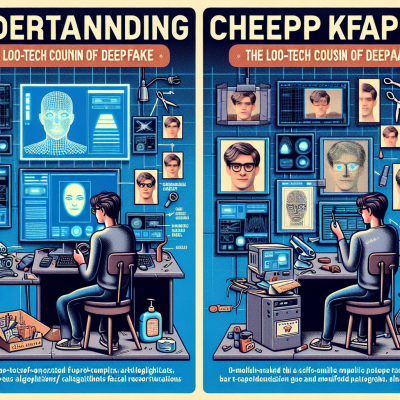
Understanding the Rise of Cheapfakes in the Digital Age
In an era where misinformation spreads faster than ever before, the rise of digitally altered media is becoming a major concern. While deepfakes—AI-generated videos and audio that convincingly mimic real people—have dominated headlines, a new and even more accessible type of media manipulation is quietly but powerfully making waves: cheapfakes.
What Are Cheapfakes?
Cheapfakes are manipulated videos, images, or audio created using basic and widely available editing tools. Unlike deepfakes, which rely on sophisticated AI and machine learning, cheapfakes are made with conventional software that nearly anyone can access.
They don’t require advanced programming skills or enormous computing power. Instead, they use simple techniques such as:
- Speeding up or slowing down video footage
- Cropping or splicing scenes
- Reversing video clips
- Editing text or dates in an image
- Altering the tone of audio
These edits can be used to misrepresent reality intentionally, often with the aim of shaping opinions, spreading propaganda, or creating sensational content.
Deepfakes vs. Cheapfakes: What’s the Difference?
Though both technologies deal with media manipulation, the key difference lies in their complexity and accessibility.
- Deepfakes are created using deep learning algorithms and neural networks. They require access to high-end hardware and sophisticated software tools.
- Cheapfakes are manually edited and require far fewer technical resources. A teenager with a smartphone and a free video-editing app can easily produce one.
While deepfakes may seem more threatening due to their realism, cheapfakes can actually be more dangerous because of their ease of creation and widespread use.
The Real-World Implications of Cheapfakes
Cheapfakes have already influenced public opinion and political narratives. A notable example is the manipulation of videos involving public figures. For instance, videos of politicians have been slowed down to make them seem intoxicated or confused. These weren’t AI-generated but manually edited with basic tools—yet they managed to go viral and seed doubt among viewers.
The accessibility of cheapfakes makes misinformation more democratic—allowing not just cybercriminals or state actors, but also regular individuals, to create and distribute misleading content.
Impact on Trust and Media Consumption
This rise in manipulated content significantly affects how we consume media. With the line between real and fake increasingly blurred, audiences are finding it harder to discern what is authentic. As trust in traditional media declines, cheapfakes capitalize on the void to reinforce echo chambers and bias confirmation.
Why Are Cheapfakes So Effective?
The human brain is wired to process visual information quickly—often quicker than we can logically analyze it. Cheapfakes exploit this vulnerability by presenting altered content that looks convincing enough on first glance. Combined with powerful emotive cues, they can sway public sentiment before fact-checking has a chance to kick in.
Additionally:
- They spread rapidly on social media, especially in highly charged political or cultural environments.
- They require minimal effort to go viral—their sensational or controversial nature ensures immediate viewer engagement.
- They are difficult to track and refute because many copies and variants surface rapidly across platforms.
Combating the Cheapfake Phenomenon
The battle against cheapfakes involves both technological and educational initiatives.
1. Media Literacy
Improving digital literacy is the first line of defense. When audiences understand that not everything they see online is automatically real, they become more cautious consumers. Empowering people with the ability to critically analyze information should be a priority in schools, workplaces, and communities.
2. Platform Accountability
Social media platforms need to enhance detection and labeling mechanisms. Some companies have started applying ‘manipulated media’ tags to content identified as edited. This needs to be scaled up and supported by community reporting features.
3. Fact-Checking Networks
Independent fact-checkers play a critical role in identifying and debunking cheapfakes. Their work needs visibility and should be integrated into social platforms in real-time, alerting users to misinformation as they encounter it.
The Future of Cheapfakes
As editing software continues to evolve, distinguishing between authentic and altered media will become even more challenging. And as AI begins to simplify even cheap editing processes further, the volume of cheapfakes available online might skyrocket.
The key moving forward will be transparency—developing systems that can verify original content, authenticate sources, and decode manipulations. While we may not be able to stop the surge of cheapfakes, understanding how they function and spread gives society the tools to respond effectively.
Conclusion
Cheapfakes represent a pressing and prevalent threat in today’s media landscape. These low-tech forgeries, while lacking the polish of deepfakes, present unique and scalable challenges in the fight against misinformation. As they continue to shape narratives and destabilize trust, it’s crucial that individuals, platforms, and policymakers collaborate to build resilience against their influence. Awareness, education, and innovation are our best weapons in this ongoing media war.


Leave a Reply